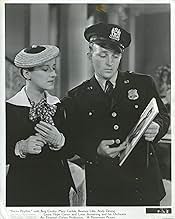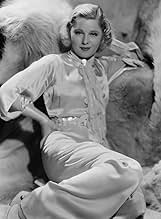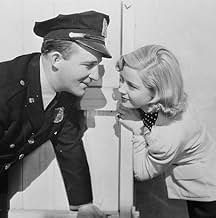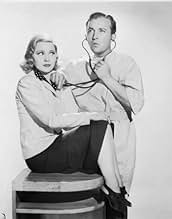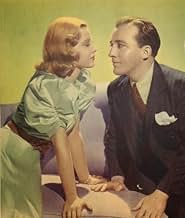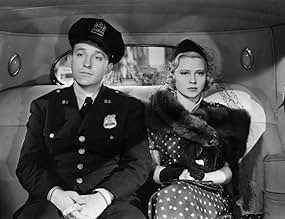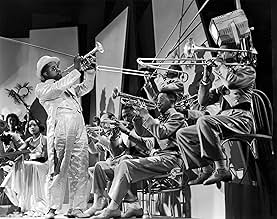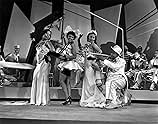Füge eine Handlung in deiner Sprache hinzuDr. Bill Remsen pretends to be a policeman, and ends up being assigned to guard Judy Marlowe. Amazingly, he falls in love with her.Dr. Bill Remsen pretends to be a policeman, and ends up being assigned to guard Judy Marlowe. Amazingly, he falls in love with her.Dr. Bill Remsen pretends to be a policeman, and ends up being assigned to guard Judy Marlowe. Amazingly, he falls in love with her.
- Auszeichnungen
- 3 wins total
Empfohlene Bewertungen
Singing doctor Bing Crosby -- I hope he's not a proctologist -- helps out enfeebled friend cop Andy Devine. He rents a uniform and takes his place, assigned to Beatrice Lillie. Her niece, Mary Carlisle, wants to elope with Fred Keating. Miss Lillie is too busy singing quodlibets, trying to buy dinner napkins, and roller-skating at a police benefit, so Crosby must forestall the younger woman.
Director Frank Tuttle expertly referees this mishmosh, with Crosby singing two solos and a duet with Miss Lillie, Keating performing a magic trick -- he was a stage magician before turning actor -- and Miss Carlisle looking pretty. Miss Lillie, of course, steals every scene she's in, repeating some of her stage routines, and holding her own against such expert farceurs as Laura Hope Crewe, Franklin Pangborn, and Sterling Holloway. The copy I looked at did not include the Louis Armstrong number, but Bing played second banana in his starring role, and liked it. As did I.
Director Frank Tuttle expertly referees this mishmosh, with Crosby singing two solos and a duet with Miss Lillie, Keating performing a magic trick -- he was a stage magician before turning actor -- and Miss Carlisle looking pretty. Miss Lillie, of course, steals every scene she's in, repeating some of her stage routines, and holding her own against such expert farceurs as Laura Hope Crewe, Franklin Pangborn, and Sterling Holloway. The copy I looked at did not include the Louis Armstrong number, but Bing played second banana in his starring role, and liked it. As did I.
My wife and I saw Dr. Rhythm when we were first married about 40 years ago. We loved it and never forgot the main song, nor Beatricy Lillie driving Franklin Pangborn crazy over the danner nipkins. For the last 20 years or so we've tried unsuccessfully to get a copy. Turner doesn't even list it. Other posters here also remember it fondly, hoping to see it again. Good news! As of January 2013 the entire film is posted on YouTube. We just watched it and it was as good as we remembered. The songs are pleasant, the actors are old favorites, including Andy Devine and Sterling Holloway. The action is unexpected and well paced. The comedy is unforced and genuine. Bea Lillie steals the show whenever she appears. Indeed, she should have received equal billing with Crosby. Why not? Only a gypsy knows!
This is one of the large number of Paramount musicals for "Der Bingle" in the 1930s and 1940s, that are mostly pleasant feasts for lovers of his crooning, entertaining in their own right, but forgettable after watching. They all have high points in them, but the films that people remember for showing Crosby the actor were made after 1940. Then came his pair of performances as Father O'Malley, his visit to the court of Franz Joseph in THE EMPEROR'S WALTZ, and eventually movies like THE COUNTRY GIRL and HIGH SOCIETY. Perhaps the best to say about the early Crosby films was they gave him the training to become the fine serious actor he turned into. They also were adequate comic training for his series of "Road" films with Bob Hope and Dorothy Lamour.
The best portions of this film (aside from Crosby's singing) is Bea Lillie's comic points. Although she would have a long film career (she was, if you recall, the villain in THOROUGHLY MODERN MILLIE in the middle 1960s) Ms Lillie's basic career was as a satirist and stage clown. With her ladylike ways and soft speech she would sit on stage singing a song about "Fairies at the Bottom of My Garden", and suddenly you were listening to a devastating criticism about modern culture. That was never (as far as I know) put on film. But her routine about buying "a Dozen Double Damasque Dinner Napkins" (from poor, flustered Franklin Pangborn) gradually roles off their betwixt and be-twiddled tongues as "a dibble dizen madeques riddle nipkins" or whatever they come up with. She also does a lovely spoof of gypsy love songs, "Only a Gypsy Knows", that includes her bashing around with a tambourine, and yelling a friendly "Hiya!" at one point. I recommend the film for fans of "Der Bingle", but also for those masters of tongue-twisted, genteel comedy, Lillie and Pangborn.
The best portions of this film (aside from Crosby's singing) is Bea Lillie's comic points. Although she would have a long film career (she was, if you recall, the villain in THOROUGHLY MODERN MILLIE in the middle 1960s) Ms Lillie's basic career was as a satirist and stage clown. With her ladylike ways and soft speech she would sit on stage singing a song about "Fairies at the Bottom of My Garden", and suddenly you were listening to a devastating criticism about modern culture. That was never (as far as I know) put on film. But her routine about buying "a Dozen Double Damasque Dinner Napkins" (from poor, flustered Franklin Pangborn) gradually roles off their betwixt and be-twiddled tongues as "a dibble dizen madeques riddle nipkins" or whatever they come up with. She also does a lovely spoof of gypsy love songs, "Only a Gypsy Knows", that includes her bashing around with a tambourine, and yelling a friendly "Hiya!" at one point. I recommend the film for fans of "Der Bingle", but also for those masters of tongue-twisted, genteel comedy, Lillie and Pangborn.
"Doctor Rhythm" (Paramount, 1938), directed by Frank Tuttle, based upon a story, "The Badge of Policeman O'Roon" by O. Henry, is a lightweight musical-comedy starring Bing Crosby, a movie that seems to be best remembered today solely for its "Double Dasmisk Dinner Napkins" routine featuring none other than comedienne Beatrice Lillie (1894-1989) in a very rare screen appearance during Hollywood's Golden Age. And she is not only very funny, but a bizarre personality who seems to be an unlikely performer to be featured in a Bing Crosby musical.
The story opens at Central Park when four alumni of Public School 43 of Brooklyn, N.Y., meet at midnight (?) for their annual reunion. The four men are Luke (Sterling Holloway), an ice cream salesman; Al (Rufe Davis), a zoo keeper; Larry O'Roon (Andy Devine), a policeman; and Doctor William Remsen (Bing Crosby), getting together, and singing the film's first tune, "P.S. 43." Because O'Roon gets nice and drunk and is unable to go on duty the following morning, Remsen decides to take his place for the day, assuming the assignment as a bodyguard to a spoiled heiress named Judy Marlowe (Mary Carlisle), engaged to a phony, Chris LeRoy (Fred Keating) who not only has a questionable past, but is only after her money. Of course, she's unaware of his scheme. After a love-hate relationship between Remsen and Judy, the thin storyline concludes with a policeman's benefit supported by Lorelei Dodge-Blodgett (Bea Lillie) who not only MC's on stage wearing roller skates, but performs in an opera burlesque number titled "Only a Gypsy Knows."
Other songs by Johnny Burke and Jimmy Monaco include: "My Heart is Taking Lessons" (sung by Crosby); "Rhythm" (sung by Bea Lillie); "On the Sentimental Side" "On the Sentimental Side" (reprise); "My Heart is Taking Lessons," "This Is My Night to Dream" (this nice sentimental tune sung by Crosby to Carlisle in the tunnel of love sequence); and "My Heart is Taking Lessons" (sung by Crosby and cast). Although I find many of the songs quite listenable, they are virtually forgotten today.
The supporting players include Franklin Pangborn and William Austin, character actors who partake in the "Double Dasmisk Dinner Napkins" routine; Laura Hope Crews, John Hamilton (the one and only Perry White of the "Superman" TV series of the 1950s) and Henry Wadsworth as Otis. As for blonde and pert Mary Carlisle, she makes her third and final appearance opposite Crosby.
Like many other musicals of the 1930s, "Doctor Rhythm" is just an excuse to have Bing Crosby going through 80 minutes or so of silly plot and introducing several tunes with a songwriter's hope that one of them will end up on the Hit Parade charts before rapping it all up in the end. While no masterpiece, "Doctor Rhythm" is a real curio, and a film's buff's dream to have it resurface again on television or video. (***)
The story opens at Central Park when four alumni of Public School 43 of Brooklyn, N.Y., meet at midnight (?) for their annual reunion. The four men are Luke (Sterling Holloway), an ice cream salesman; Al (Rufe Davis), a zoo keeper; Larry O'Roon (Andy Devine), a policeman; and Doctor William Remsen (Bing Crosby), getting together, and singing the film's first tune, "P.S. 43." Because O'Roon gets nice and drunk and is unable to go on duty the following morning, Remsen decides to take his place for the day, assuming the assignment as a bodyguard to a spoiled heiress named Judy Marlowe (Mary Carlisle), engaged to a phony, Chris LeRoy (Fred Keating) who not only has a questionable past, but is only after her money. Of course, she's unaware of his scheme. After a love-hate relationship between Remsen and Judy, the thin storyline concludes with a policeman's benefit supported by Lorelei Dodge-Blodgett (Bea Lillie) who not only MC's on stage wearing roller skates, but performs in an opera burlesque number titled "Only a Gypsy Knows."
Other songs by Johnny Burke and Jimmy Monaco include: "My Heart is Taking Lessons" (sung by Crosby); "Rhythm" (sung by Bea Lillie); "On the Sentimental Side" "On the Sentimental Side" (reprise); "My Heart is Taking Lessons," "This Is My Night to Dream" (this nice sentimental tune sung by Crosby to Carlisle in the tunnel of love sequence); and "My Heart is Taking Lessons" (sung by Crosby and cast). Although I find many of the songs quite listenable, they are virtually forgotten today.
The supporting players include Franklin Pangborn and William Austin, character actors who partake in the "Double Dasmisk Dinner Napkins" routine; Laura Hope Crews, John Hamilton (the one and only Perry White of the "Superman" TV series of the 1950s) and Henry Wadsworth as Otis. As for blonde and pert Mary Carlisle, she makes her third and final appearance opposite Crosby.
Like many other musicals of the 1930s, "Doctor Rhythm" is just an excuse to have Bing Crosby going through 80 minutes or so of silly plot and introducing several tunes with a songwriter's hope that one of them will end up on the Hit Parade charts before rapping it all up in the end. While no masterpiece, "Doctor Rhythm" is a real curio, and a film's buff's dream to have it resurface again on television or video. (***)
The film starts out slow, but jumps to full speed whenever Bea Lillie is on screen. Mostly just a jumble of tedious situation comedy bumbling, the film is saved by Ms. Lillie's musical numbers and her "double-damask dinner napkin" routine with Franklin Pangborn.
Wusstest du schon
- WissenswertesBob Hope is in studio records/casting call lists for a role in this film, but he is not seen.
Top-Auswahl
Melde dich zum Bewerten an und greife auf die Watchlist für personalisierte Empfehlungen zu.
Details
- Erscheinungsdatum
- Herkunftsland
- Sprache
- Auch bekannt als
- The Badge of Policeman O'Roon
- Drehorte
- Produktionsfirma
- Weitere beteiligte Unternehmen bei IMDbPro anzeigen
- Laufzeit1 Stunde 20 Minuten
- Farbe
- Seitenverhältnis
- 1.37 : 1
Zu dieser Seite beitragen
Bearbeitung vorschlagen oder fehlenden Inhalt hinzufügen


